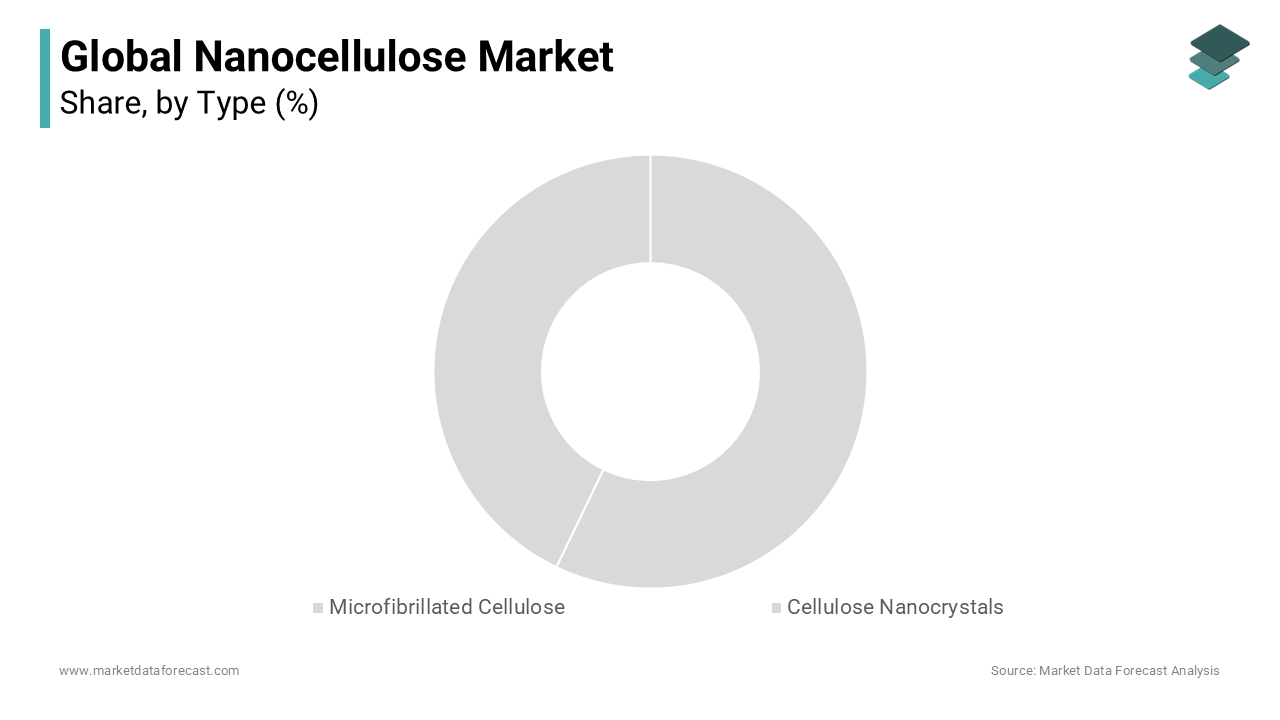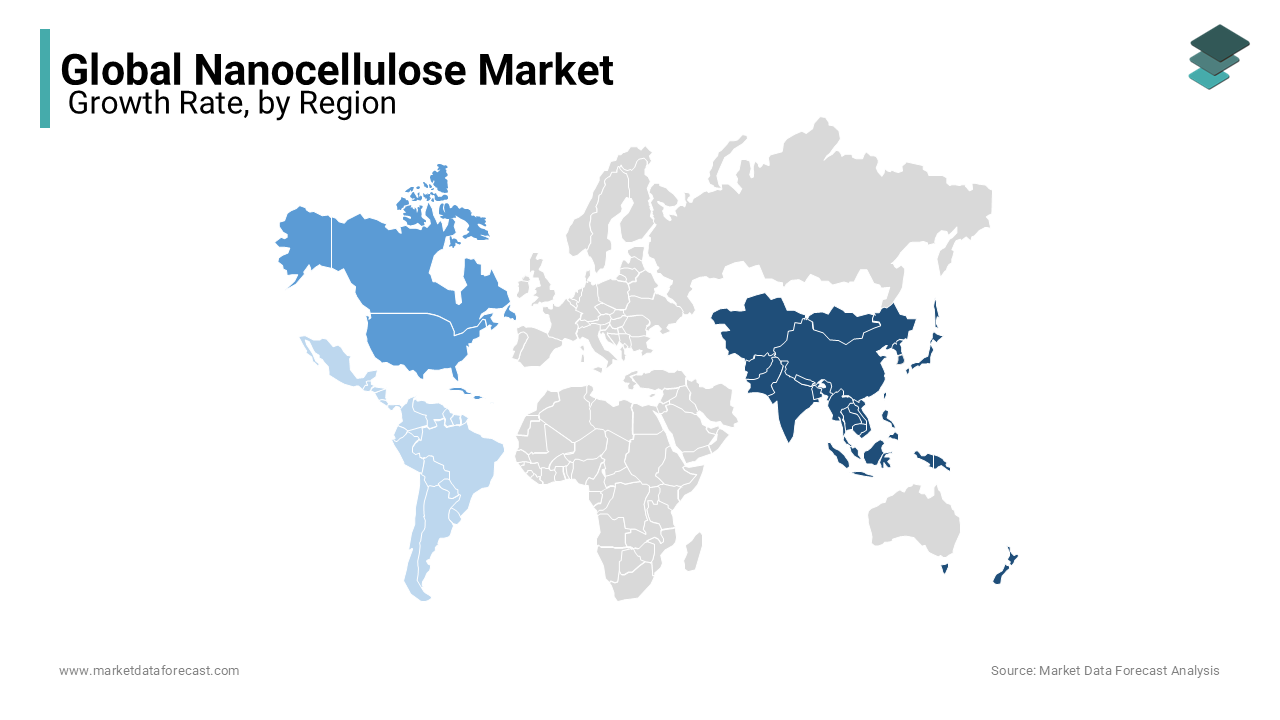Global Nanocellulose Market Size, Share, Trends & Growth Forecast Report – Segmented By Type (Microfibrillated Cellulose, Cellulose Nanocrystals), Application (Pulp& paper, Composites & packaging, Biomedical & pharmaceuticals, Electronics & sensors), and and Region (North America, Latin America, Europe, Asia Pacific, Middle East & Africa) - Industry Analysis From 2024 to 2032
Global Nanocellulose Market Size (2024 to 2032)
The global nanocellulose market size is expected to reach USD 501.96 million in 2024 and is anticipated to reach a valuation of USD 2129.73 million by 2032 and it is predicted to register a CAGR of 19.8% during the forecast period 2024 to 2032.

Current Scenario of the Global Nanocellulose Market
Nanocellulose is defined as a material derived from wood fibers and is chosen for its maximum strength at the same time as a lightweight material called Kevlar. nanocellulose, unlike Kevlar, is completely renewable and is perfect for making light and solid body armor. In fact, they are used to make super versatile displays.
Nanocellulose is a light solid material acquired from plant matter that is made of nano-sized cellulose fibrils. Nanocellulose has broad varying applications due to its properties of being lightweight, stiffer than Kevlar, electrically conductive, non-toxic, excellent tensile strength, and absorbent when employed as a basis for aerogels or foams. Nanocellulose is a thin solid material obtained from plant matter that is made of nano-sized cellulose fibrils. It is a pseudo-plastic material and shows the properties of specific types of gels or fluids, which are usually thick in reasonable conditions. It is generally derived from wood pulp though it can be made from any cellulosic source material. It is employed to enhance the rheology of food, pharmaceuticals, and cosmetics. The availability of raw materials in more quantity and the advancement of innovative applications is estimated to boost the call. On account of its features such as biodegradability and excellent tensile strength and strength-to-weight ratio, Nanocellulose materials are finding huge demand in sectors like biomedical, healthcare and packaging and composites segments. The presence of naturally occurring raw materials in large quantities, and also increasing investment in research and advancement activities, is offering a significant boost to the market expansion.
MARKET DRIVERS
Nanocellulose is estimated to alternate a range of present products in the future; hence, reproducible and reliable data must be obtained for the commercialization of nanocellulose products and to gain consumer trust. Nanocellulose makers and research institutes are estimated to play a major role to overcome trust concerns related to introducing of latest nanocellulose products. Appropriate promotional activities and product positioning are determined to guide consumers toward the adoption of nanocellulose products. Government support, a massive number of capital investors, and a good supply chain will also play a significant role in escalating market penetration across the world.
The expansion of the global nanocellulose market is driven by factors like major R&D activities on the worldwide level, technological developments in manufacturing procedures and cost rise, and scarcity of petroleum and artificial chemical materials. According to the Energy Information Association's report, in 2010, the global consumption of petrochemical products was close to 85 million barrels per day, which escalated to 87.1 million barrels in 2011. Therefore, a requirement for an alternative for petrochemical products is estimated to drive the world market of nanocellulose. The call for Nanocellulose is predicted to showcase a major expansion over the forecast period due to the rising oil & gas industry. Additionally, the continuous growth of the paints & coatings segment, along with the call for biodegradable material, is supposed to boost the market expansion.
MARKET RESTRAINTS
Lack of awareness, availability of technical barriers, and also a shortage of scientific experts are anticipated to be the key drag on the expansion of the market. The high price of R&D and the lack of technological developments in some areas of the world is estimated to hamper the expansion of the market.
MARKET OPPORTUNITIES
Rising crude oil production across the world is estimated to drive market expansion in the coming years. Moreover, fast urbanization, combined with increasing disposable income in growing economies, is foreseen to fuel the call during the forecast period.
MARKET CHALLENGES
Economic barriers are likely to pose a great challenge to the expansion of the global nanocellulose market in the coming years.
REPORT COVERAGE
|
REPORT METRIC |
DETAILS |
|
Market Size Available |
2023 to 2032 |
|
Base Year |
2023 |
|
Forecast Period |
2024 to 2032 |
|
CAGR |
19.8% |
|
Segments Covered |
By Type, Application, and Region. |
|
Various Analyses Covered |
Global, Regional & Country Level Analysis, Segment-Level Analysis, DROC, PESTLE Analysis, Porter’s Five Forces Analysis, Competitive Landscape, Analyst Overview of Investment Opportunities |
|
Regions Covered |
North America, Europe, Asia Pacific, Latin America, Middle East and Africa. |
|
Market Leaders Profiled |
Innventia (Sweden), American process (us), FP innovations (Canada), cellulose (Canada), stora enso (Finland), Kruger (Canada), diesel fine chem (japan), borregaard (Norway), Nippon paper (japan), and upm-kymmene Oyj (inland), and Others. |
SEGMENTAL ANALYSIS
Global Nanocellulose Market By Type

Microfibrillated cellulose constituted the largest market share of nanocellulose in 2023. factors driving the microfibrillated segment include increasing demand for paper and pulp nanocellulose in developed economies.in recent years, the use of microfibrillated cellulose has increased due to factors such as lower manufacturing costs and emerging applications such as oil & gas drilling fluids.
Global Nanocellulose Market By Application
Pulp & paper is the main application segment in the nanocellulose industry. nanocellulose may be used as additives in papermaking to produce lighter and stronger paper.
REGIONAL ANALYSIS

Asia Pacific nanocellulose market is assumed to rise at the fastest CAGR over the forecast period due to the growth of composites & packaging and also the automotive segment.
The call for nanocellulose is expected to increase in different countries of Asia Pacific like China, India, Vietnam, Thailand, Malaysia, Bangladesh, South Korea, and Japan on account of the rising middle-class population together with the continuous expansion of latest purchase of lightweight components for automobiles.
North America has risen as the biggest market for nanocellulose, followed by Europe and the Asia Pacific.
North America is estimated to showcase a moderate expansion on account of high consumption potential, increasing production capacities, and rising economic expansion rate. In the North American Nanocellulose Market, countries like the US and Canada are among the key contributors to the regional expansion of this business and are estimated to see a high demand during the outlook period.
Germany and the UK have risen as a significant customer market on account of growing automotive production and sales together with increasing demand for lightweight passenger cars in the Europe nanocellulose market.
Latin American countries like Argentina, Colombia, and Brazil are also expected to showcase moderate expansion owing to increasing customer spending on cosmetics and personal care products. The Middle East & Africa nanocellulose business is estimated to showcase significant development during the projection period owing to the high expansion of the oil & gas business within the area.
KEY MARKET PLAYERS
The major key players in the global Nanocellulose Market are Innventia (Sweden), American Process (us), Fp Innovations (Canada), Cellulose (Canada), Stora enso (Finland), Kruger (Canada), Diacel Finechem (japan), Borregaard (Norway), Nippon paper (japan), Upm-kymmene Oyj (Finland), and others
RECENT HAPPENINGS IN THE MARKET
-
MoRe Research, along with Swedish universities makes a significant investment in research within the nanocellulose field. A combination of two postdocs and one licentiate will be working on the advancement of applications and techniques for the production of demonstration material from nanocellulose.
-
Borregaard and logistics business Borg Havn is constructing a modern, sustainable lignin warehouse in Øra, near Fredrikstad in Norway. The structure of this latest 19,000 square-meter warehouse is presently being built with 330 tonnes of beams produced by ArcelorMittal Europe – Long Products Sections and Merchant Bars' mill in Belval, Luxembourg.
DETAILED SEGMENTATION OF THE GLOBAL NANOCELLULOSE MARKET INCLUDED IN THIS REPORT
This research report on the global nanocellulose market has been segmented and sub-segmented based on type, application, and region.
By Type
- Microfibrillated Cellulose
- Cellulose Nanocrystals
By Application
- Pulp & Paper
- Composites & Packaging
- Biomedical & Pharmaceuticals
- Electronics & Sensors
By Region
- North America
- Europe
- Asia Pacific
- The Middle East and Africa
- Latin America
Related Reports
Access the study in MULTIPLE FORMATS
Purchase options starting from $ 2500
Didn’t find what you’re looking for?
TALK TO OUR ANALYST TEAM
Need something within your budget?
NO WORRIES! WE GOT YOU COVERED!
Call us on: +1 888 702 9696 (U.S Toll Free)
Write to us: [email protected]